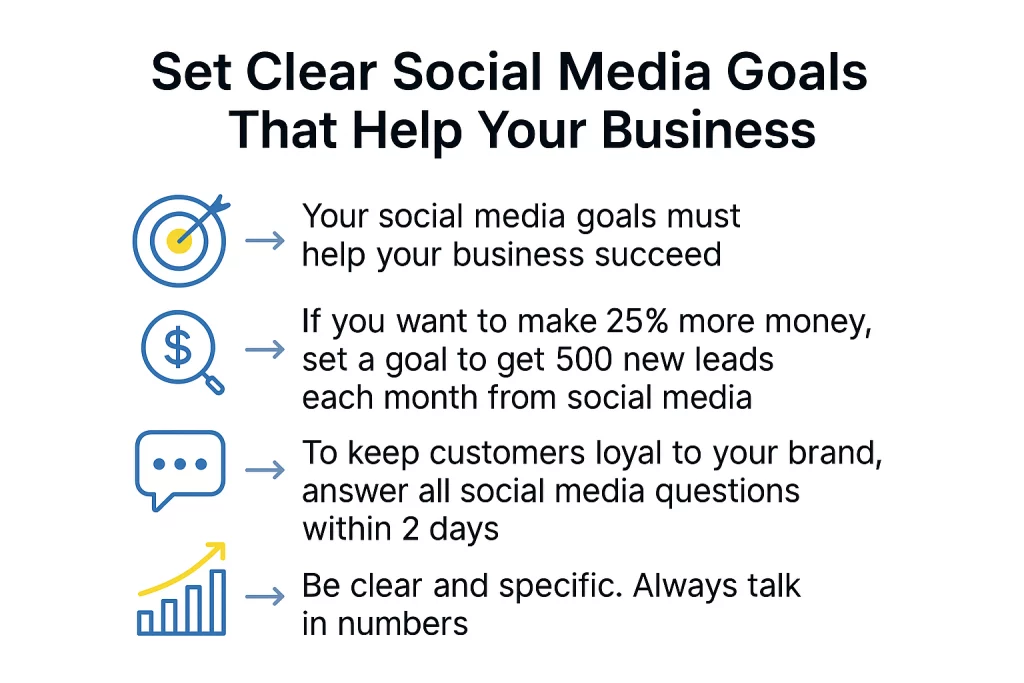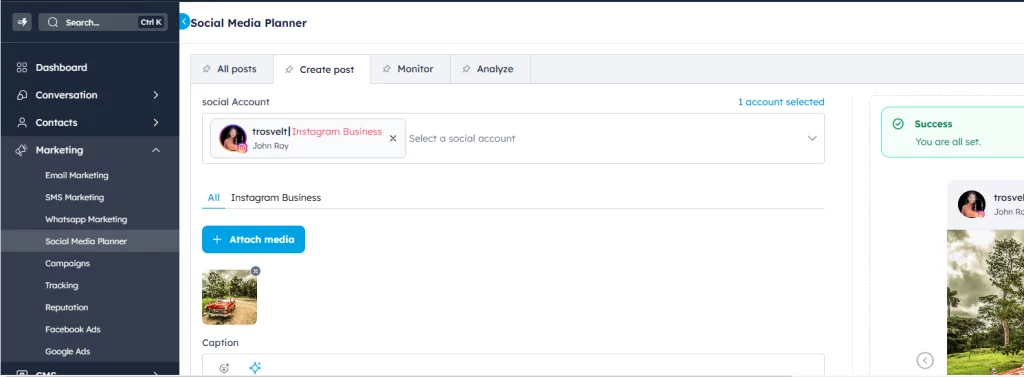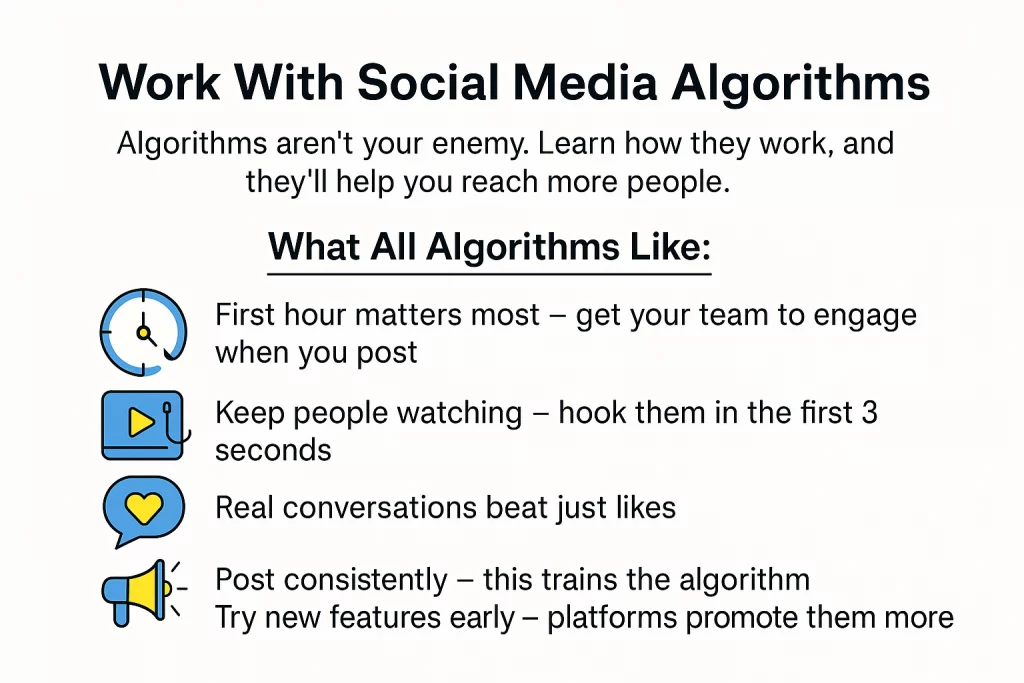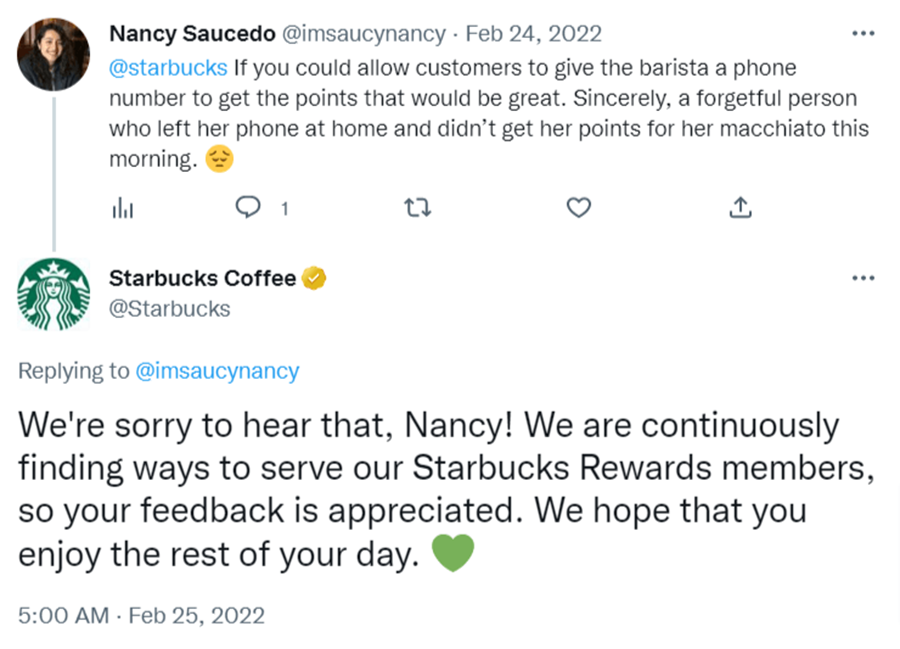‘You don’t sell shoes to a person who is looking for a shirt.’
This is what most of the online businesses do. Show the customers what they want, not what you want to display to them.
Posting on social media without getting any results isn’t just a waste of time but resources and manpower too. Every business experiences now and then. But what matters and drives Success is how you make and implement a social media strategy.
Studies show that 73% of business owners can’t prove their social media is making money. And 68% can’t create Content that people actually care about.
If this sounds like you, don’t worry – you can fix this.
AI makes it easier to create Content. You can understand what your followers want and deliver it right on time.
What Makes a Real Social Media Strategy?
A social media strategy is much more than a pretty calendar with post ideas. It’s not just about when to post or which hashtags to use.
It’s your complete plan for reaching your brand goals through social media. Think of it like building a bridge. One side is what your business needs. The other side is what your customers want. Your strategy connects them both.
Your strategy framework must answer these five important questions:
- Who are we trying to reach?
- What business goals will social media help us reach?
- Where should we post?
- How do we make content people actually want to see?
- When will we know if it’s working?
Can’t answer these? Then you don’t have a strategy. You’re just posting and hoping something works.
Why Your Business Needs a Social Media Strategy Right Now
What Happens When You Don’t Have a Plan
Here’s what happens without a social media strategy: Companies waste around 12 hours each week creating Content that no one sees. They get 60% less engagement than businesses that actually plan ahead.
But that’s just the beginning of the problem.
Lost Money:
Social media shopping will reach $100 billion in the US by 2026. Also, 41% of customers now research brands mainly through social media.
If your digital marketing plan doesn’t include this, you’re invisible to almost half of your potential customers.
Falling Behind Competitors:
As you share the same dull quotes each week, your competitors are creating real strategies and gaining loyal followers.
They’re becoming the trusted voices in your industry. They’re turning followers into customers. Every day without a strategy is another day they get ahead of you.
Team Problems:
Without clear social media planning, your team always feels stressed. They’re always reacting, never planning. The result?
Your messages are confusing, people do the same work twice, and your best workers get burned out and quit.
The 10-Step Social Media Strategy That Works
Step 1: Set Clear Social Media Goals That Help Your Business

Your social media goals must help your business succeed. Start with what your business needs, then figure out how social media can deliver it.
If you want to make 25% more money, set a goal to get 500 new leads each month from social media.
To keep customers loyal to your brand, answer all social media questions within 2 days.
Be clear and specific. Always talk in numbers. Example: ‘Get more likes’ is wrong, instead use, ‘increase Instagram likes from 100 to 200 per post in a week.’
Pick only 3-5 main goals. More than that, and you’ll fail at everything.
Step 2: Know Your Customers Really Well

Knowing basic facts about your customers isn’t enough anymore. You need to know what worries them at night and what Content makes them pause.
Start by checking your social media stats to see who actually follows you. Review your website visitor stats and look over customer information from past sales.
Have real conversations with 10-15 customers and send them short surveys they’ll actually fill out. Talk to your sales team because they know what customers really want and worry about.
Create 2-3 detailed customer profiles that include their age, job, goals, and daily problems. Find out when they check social media and how they want brands to talk to them.
Here’s an example: Marketing Director Maria is 35-45 years old and has worked in marketing for 10+ years. She wants to prove marketing works, but has a small budget and tiny team. She uses LinkedIn daily and loves real case studies but hates fake advice.
Step 3: Study Your Competitors
Your competitors are doing free experiments for you. Learn from what works and what doesn’t work for them.
Find 5-7 competitors, including 3-4 direct competitors and 2-3 companies you admire.
Set a meeting with your team and put the data in a presentation. Analyse which platforms work best for them and what kind of content drives more engagement.
Then, find out how often they post, when they post, and how they respond to comments.
Pay attention to the campaigns that kept people talking about their brands.
Find missed chances, like customers who’re not engaging or content types they haven’t tried. Find platforms they overlook and topics they avoid. These could be your biggest chances.
Step 4: Right Platform
| Platform | Best For | Main Users | Content Types | Business Type |
|---|---|---|---|---|
| Professional content, B2B | Working adults 25-54 | Articles, videos | 80% B2B | |
| Visual stories, brand personality | Young adults 18-34 | Stories, Reels, photos | 70% B2C | |
| Building communities | Adults 25-54 | Videos, links, groups | Both | |
| TikTok | Going viral, reaching teens | Teens 16-24 | Short videos | 85% B2C |
| News and conversations | Adults 25-49 | Quick posts, threads | Both | |
| YouTube | Teaching and tutorials | All ages | Long videos | Both |
How to Choose:
- Where do your customers actually spend time?
- What Content can you create on a regular basis?
- Where are competitors getting real results?
- Which platforms help you reach your social media marketing objectives?
My rule: Spend 70% of your time on two main platforms, 20% on 1-2 backup platforms, 10% testing new ones.
Step 5: Create Your Content Plan
Content is the fuel that makes everything work. Bad Content = failed strategy, no matter how good your plan looks.
Content Types to Focus On:
- Educational Content (40%): Teach something useful
- Fun/Entertaining (25%): Show your human side
- Customer Stories (20%): Let customers tell your story
- Promotional (10%): Yes, you can sell – just don’t overdo it
- Industry Opinions (5%): Share thoughts that matter
Different Content Formats Work for Different Things:
- Short videos: Getting discovered and going viral
- Photo carousels: Teaching detailed lessons
- Stories: Showing behind-the-scenes Content
- Long posts: Showing you’re an expert
- Live videos: Connecting in real-time
Step 6: Make a Posting Schedule You Can Stick To

First, be consistent, then get perfect along the way. Create a system that your team can actually follow.
How Often to Post:
- LinkedIn: 2-5 times per week
- Instagram: 4-7 posts weekly, 2-3 Stories daily
- Facebook: 3-5 times per week
- TikTok: 3-5 times per week minimum
- Twitter: 3-5 times daily
My Simple Workflow:
- Week 1: Think of content ideas
- Week 2: Create Content in batches
- Week 3: Get everything approved
- Week 4: Schedule posts
- Every day: Reply to comments and check results
Step 7: Work With Social Media Algorithms

Algorithms aren’t your enemy. Learn how they work, and they’ll help you reach more people.
What All Algorithms Like:
- First hour matters most – get your team to engage when you post
- Keep people watching – hook them in the first 3 seconds
- Real conversations beat just like
- Post consistently – this trains the algorithm
- Try new features early – platforms promote them more
Step 8: Respond to Your Audience
Look at how Starbucks handle the frustrating customer:

Response Time Goals:
- Crisis situations: Within 1 hour
- Purchase questions: Within 4 hours
- General comments: Within 24 hours
Who to Respond to First:
- Angry customers (others are watching)
- People ready to buy (money is waiting)
- Happy customers (amplify their love)
- General comments (keep conversations going)
Step 9: Measure What Matters
Track the right numbers, not just the easy ones.
Numbers That Don’t Matter Much:
- Follower count
- Likes
- Views
Numbers That Actually Matter:
- How many people engage with your posts
- How many people share your Content
- How many people click your links
- How much money does social media make you
- How much does it cost to get new customers
When to Check Your Numbers:
- Daily: Quick health checks
- Weekly: Look for trends
- Monthly: Full review
- Every 3 months: Update your strategy
Step 10: Keep Improving Your Strategy

Your social media strategy needs constant updates and improvements.
Monthly Review Process:
1. Look at what worked:
- What did better than expected?
- What completely failed?
- What changed in your industry?
2. Test new things:
- Try one new thing at a time
- Give tests enough time to work
- Write down everything you learn
3. Stay current:
- Platform updates
- New content formats
- What competitors are doing
4. Make changes:
- Move resources to what works
- Fix what’s broken
- Update your content themes
Your 4-Week Action Plan
Success doesn’t happen by accident. Here’s what to do in the next four weeks:
Week 1: Identify your customers and define clear goals.
Week 2: Research competitors and choose your platforms.
Week 3: Plan content types and create posts for the first month.
Week 4: Set up tracking and measure your starting point.
Conclusion:
Social media has given wider opportunities to businesses. You are not bound to one region, like a physical store. In fact, you can use the E-commerce platforms to reach a global audience.
With proper tools combined with AI, and with one priority, ‘Great Customer experience’, your business will surely reach new heights.
‘Live in reality. Follow the numbers, not the hope.’ When you work according to data, you grasp what’s going on. This also helps to create a practical system that brings in higher results.
